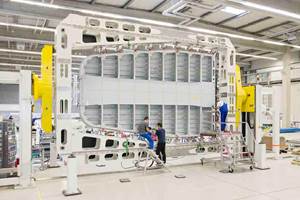Evonik is conducting research on biodegradable composites
The research is focused on new composite materials for the fixation of fractured bones.
Evonik, Essen, Germany, is conducting research into biodegradable high-strength composites that could potentially replace metal in implants used for the internal fixation of fractured bones. Implants play a key role in supporting bones until they heal. Today’s metallic devices typically remain in the body for the rest of the patient’s life or require additional surgery for removal. By contrast, devices made with Evonik’s new composites will be absorbed by the body gradually once the bone healing process has taken place. These materials consist of polymers and of substances that naturally occur in bones. Evonik’s research is still in its early stages.
The project is one of a number currently being conducted at the Medical Devices Project House in Birmingham, Ala, which employs a team of more than 20 experts. Its mission is to develop new medical technology solutions and materials, with a particular emphasis on implants. Andreas Karau, head of the project house, explains the researchers’ vision: "In the long term, our focus is regenerative medicine. We want to create bioabsorbable implants to replace damaged tissues with healthy tissues. Our current work on biodegradable composites is a first step in this direction."
The number of implants required for the fixation of bone fractures is substantial: osteoporosis, for example, is responsible for 8.9 million fractures every year. The U.S. commands the largest share of the global market by far, with 40 percent. Moreover, American companies are major players in implant technology. Other key medical technology markets include Europe and Japan.
"Our leading position in polylactic acid-based polymers is an excellent foundation for the development of materials and solutions for regenerative medicine," explains Karau. The polymers break down into carbon dioxide and water. Degradation time depends on their molecular composition, chain length, and crystallinity. They can last from a few weeks to many months – providing plenty of time for bones or other tissues to regenerate.
Medical device manufacturers use RESOMER polymers marketed by Evonik’s Health Care Business Line to make bioabsorbable screws, pins and small plates. These are primarily used for torn ligaments in the knee or shoulder, and for fixation of smaller bones in fingers or the face.
However, as Karau notes, "At the moment, the materials we have available are not strong enough to be used for large, load-bearing bones." Consequently, the researchers at Medical Devices Project House are exploring composite materials that reinforce biodegradable polymers with inorganic substances, such as derivatives of calcium phosphate. Not only do these additives strengthen the material, they enhance its biocompatibility. "As the polymers gradually break down, calcium and phosphate can be absorbed into the newly formed bone tissue," Karau explains.
With the right materials, they could harness 3D printing to create made-to-measure implants for individual patients. One of the goals of Evonik’s researchers in Birmingham is to make its biodegradable polymers suitable for this additive manufacturing process.
Karau adds: "In the long term, we intend to develop polymeric scaffolds that could be colonized with living cells – creating a true biological implant." This approach would make it possible to regenerate cartilage, for example – or to replace damaged heart tissue with healthy tissue. However, the researchers must first find ways to improve the materials’ biocompatibility.
Creavis Project Houses typically concentrate on a defined field for a period of three years, and collaborate with multiple Business Lines. Once the project draws to a close, the researchers return to their respective Business Lines – one of which markets the resulting products and technologies. Since 2000, Evonik has established a total of 11 Project Houses.
Related Content
JEC World 2024 highlights: Thermoplastic composites, CMC and novel processes
CW senior technical editor Ginger Gardiner discusses some of the developments and demonstrators shown at the industry’s largest composites exhibition and conference.
Read MoreThermoplastic composites: Cracking the horizontal body panel nut
Versatile sandwich panel technology solves decades-long exterior automotive challenge.
Read MoreWelding is not bonding
Discussion of the issues in our understanding of thermoplastic composite welded structures and certification of the latest materials and welding technologies for future airframes.
Read MoreFrom the CW Archives: Airbus A400M cargo door
The inaugural CW From the Archives revisits Sara Black’s 2007 story on out-of-autoclave infusion used to fabricate the massive composite upper cargo door for the Airbus A400M military airlifter.
Read MoreRead Next
Cutting 100 pounds, certification time for the X-59 nose cone
Swift Engineering used HyperX software to remove 100 pounds from 38-foot graphite/epoxy cored nose cone for X-59 supersonic aircraft.
Read MoreScaling up, optimizing the flax fiber composite camper
Greenlander’s Sherpa RV cab, which is largely constructed from flax fiber/bio-epoxy sandwich panels, nears commercial production readiness and next-generation scale-up.
Read MoreCeramic matrix composites: Faster, cheaper, higher temperature
New players proliferate, increasing CMC materials and manufacturing capacity, novel processes and automation to meet demand for higher part volumes and performance.
Read More












